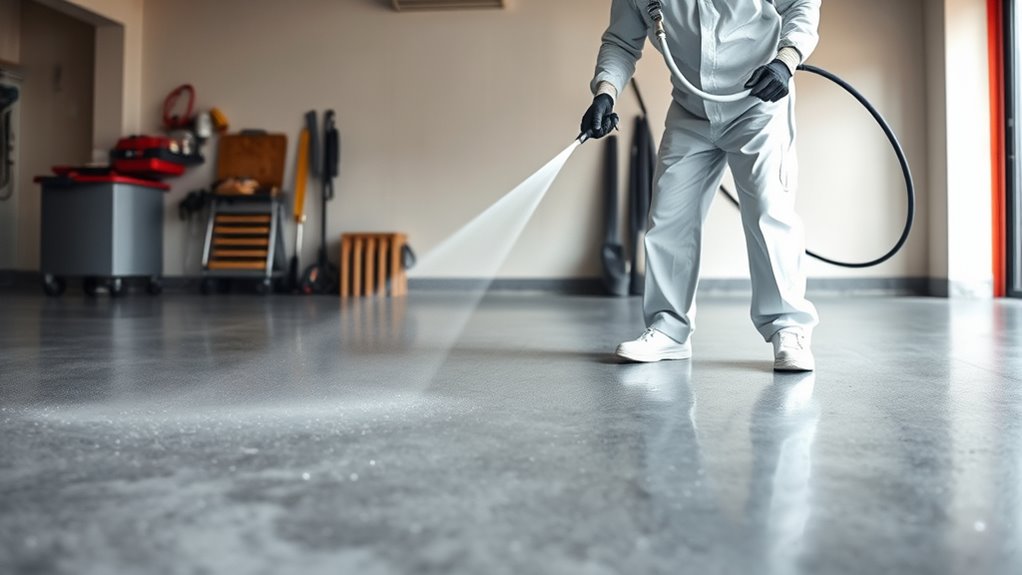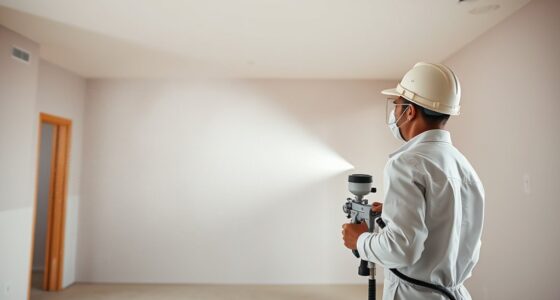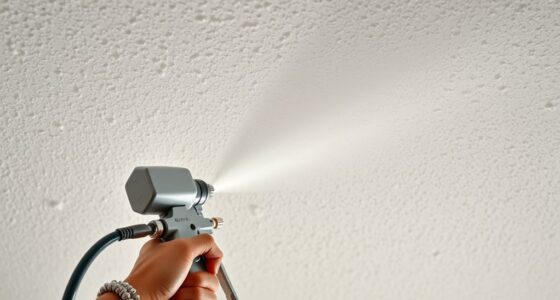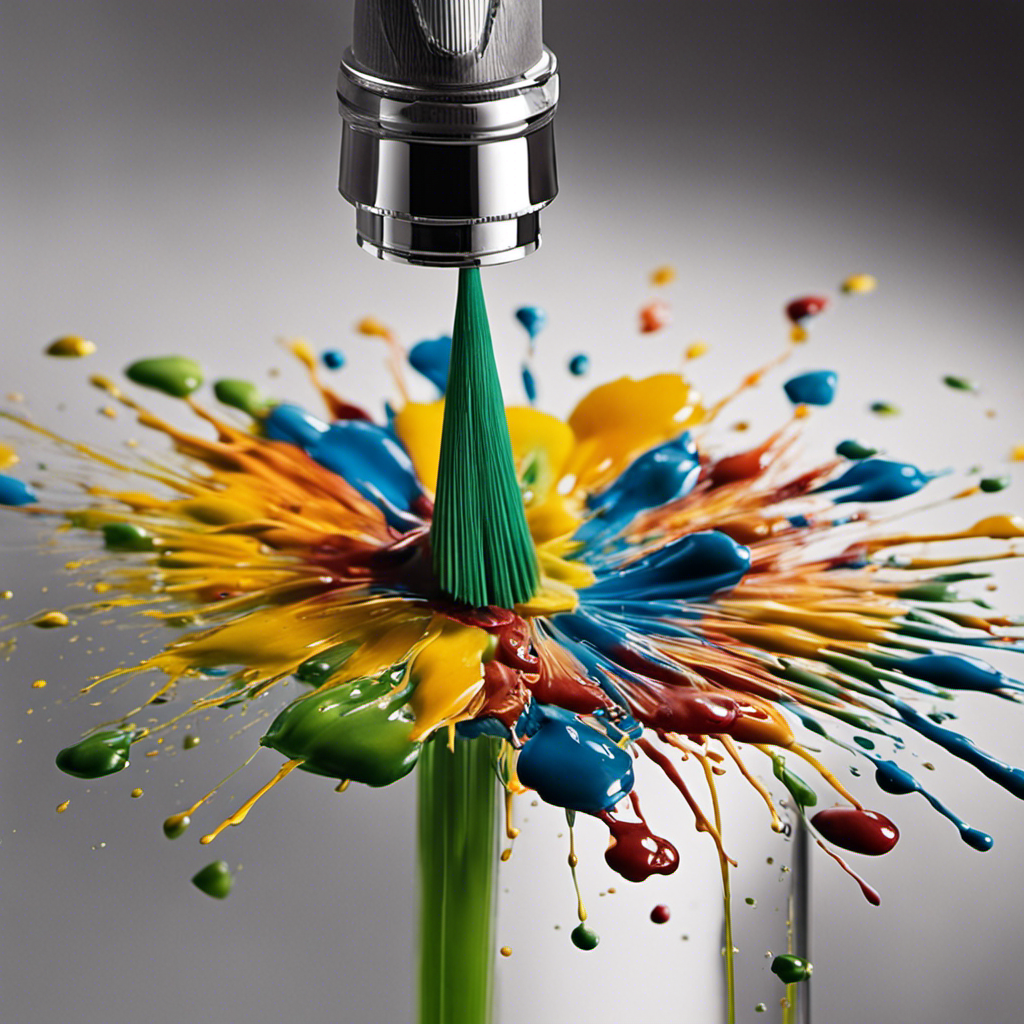Before spraying concrete floors and garages, clear the area of debris, sweep or vacuum thoroughly, and wash with a suitable cleaner. Wear safety gear, guarantee proper ventilation, and practice on scrap surfaces to master your spray technique. Maintain consistent pressure and keep the spray 6-12 inches from the surface for even coverage. Allow the coating to dry fully before use, and sealing afterward boosts durability. Keep going for detailed tips to perfect your process.
Key Takeaways
- Thoroughly clean, sweep, and inspect the surface for cracks before spraying concrete floors and garages.
- Wear appropriate safety gear and ensure proper ventilation during application.
- Use a professional-grade sprayer, practicing on a test area for even coverage and consistent technique.
- Apply the coating in smooth, overlapping passes, maintaining 6-12 inches from the surface.
- Allow the coating to fully dry, then seal the concrete for increased durability and easier maintenance.

Spraying concrete floors and garages offers a fast and efficient way to achieve a smooth, durable surface. If you’re considering tackling this project on your own, understanding DIY techniques is essential to ensure a successful and safe outcome. First, you’ll need to prepare your space thoroughly. Clear out all furniture, tools, and debris from the garage or area you’re working on. Sweep or vacuum the surface to remove loose dirt, dust, and any small particles that could interfere with adhesion. For better results, wash the floor with a concrete cleaner or a mixture of water and mild detergent, then let it dry completely. Proper surface prep is crucial for the spray coating to bond well and last longer. Additionally, inspecting the surface for cracks or damage beforehand can help ensure a more uniform finish.
Proper surface preparation is key for durable, professional-looking spray-coated concrete floors.
When it comes to the spraying process itself, safety precautions should be your top priority. Always wear appropriate personal protective equipment, including a respirator mask designed for dust and fumes, safety goggles, gloves, and long sleeves to shield your skin from splatters. Adequate ventilation is vital, especially if you’re working indoors; open windows and doors or use fans to ensure fresh air circulation. Keep a fire extinguisher nearby, just in case, and avoid working near heat sources or open flames, as some concrete sealers and coatings can be flammable.
Using DIY techniques for spraying involves selecting the right equipment. A professional-grade sprayer with adjustable pressure settings works best, but if you’re on a budget, rental equipment can be a good option. Before starting, practice on a scrap piece of concrete or a small hidden section to get comfortable with the spray pattern and coverage. Keep the sprayer moving in smooth, overlapping passes to avoid streaks or uneven patches. Maintain a consistent distance from the surface, typically around 6-12 inches, to ensure even coverage. Proper equipment maintenance and calibration are also essential for achieving the best results.
Once the spraying is complete, allow the coating to dry as per the manufacturer’s instructions. During this time, continue to observe safety precautions by keeping the area well-ventilated and avoiding contact with wet surfaces. After the coating has dried, inspect your work for any missed spots or thin patches and apply touch-ups if needed. Sealing your concrete not only enhances durability but also makes future cleaning easier. Remember, patience and proper safety measures are key to achieving a professional-looking finish when spraying concrete floors and garages yourself.
Frequently Asked Questions
How Long Does Spraying a Concrete Floor Typically Take?
Spraying a concrete floor usually takes about 2 to 4 hours, depending on the area size and application techniques. You’ll want to guarantee proper equipment maintenance for smooth operation and consistent coverage. Rushing the process can lead to uneven sealing, so take your time to prep the surface thoroughly. With the right approach, you can efficiently complete the job without sacrificing quality, making sure the seal lasts longer.
What Safety Precautions Should I Follow During Spraying?
You should always wear proper personal protective equipment, like masks, goggles, and gloves, to shield yourself from fumes and particles. Make sure to prioritize ventilation considerations by working in well-ventilated areas or using exhaust fans to disperse harmful vapors. Keep a close eye on your surroundings, and if fumes become overwhelming, take breaks or pause spraying until it’s safe. Safety first guarantees a smooth, injury-free project.
Can I Spray Concrete Floors in Cold or Rainy Weather?
Sure, go ahead and spray your concrete floors in cold or rainy weather—if you enjoy wasting time and effort! Weather impact is significant; rain and low temperatures can ruin the finish, and equipment considerations become tricky. Cold temps slow curing, while rain causes uneven coating. For best results, wait for clear, warm days. Otherwise, you’ll just end up with a sloppy, uneven mess that’ll make you wish you’d waited.
How Do I Choose the Right Sealing Product?
To choose the right sealing product, you need to consider the sealant types available, like epoxy, acrylic, or polyurethane, and match them to your specific needs. Think about whether your floor needs protection from stains, moisture, or wear. Assess the surface’s condition and environment, then select a sealant that offers durability, flexibility, and ease of application. Properly choosing the right sealant ensures long-lasting, effective protection for your concrete floor.
What Maintenance Is Required After Sealing the Floor?
After sealing your floor, you should establish a regular cleaning routine using mild detergents and avoid harsh chemicals to maintain the seal. To keep it in top shape, plan for reapplication every 2-3 years, depending on wear and tear. Promptly clean spills to prevent staining, and sweep frequently to remove debris, ensuring the seal stays intact and your floor looks great longer.
Conclusion
Now you’re all set to spray your concrete floors and garages with confidence. Proper prep and sealing can make a world of difference, protecting your space for years to come. Remember, a job done right the first time saves you trouble down the road. Don’t put off the work—get your project rolling and see how it transforms your space. When it comes to concrete, it’s better to be safe than sorry!
Franz came aboard the Paint Sprayer Zone team with a background in both journalism and home renovation. His articulate writing style, combined with a passion for DIY projects, makes him an invaluable asset. Franz has a knack for breaking down technical jargon into easy-to-understand content, ensuring that even the most novice of readers can grasp the complexities of paint sprayers.










